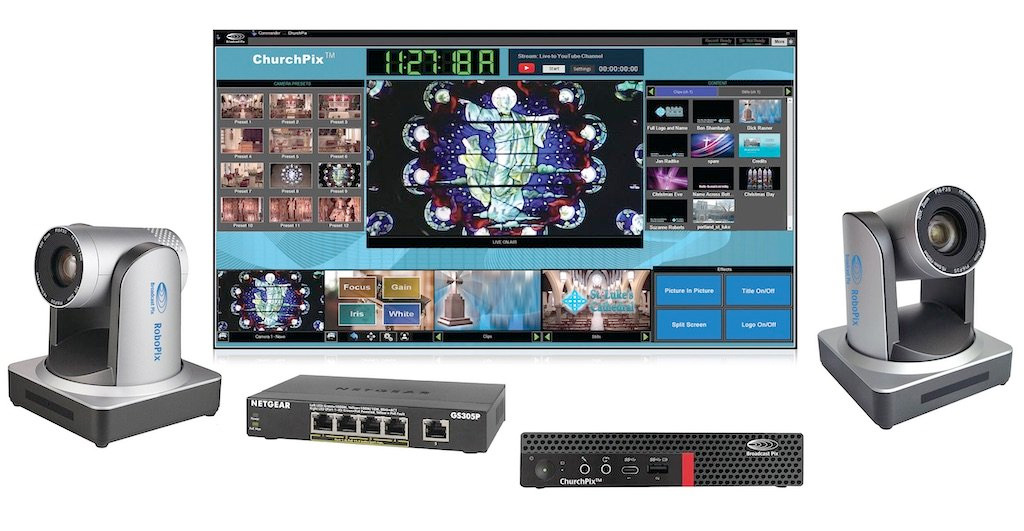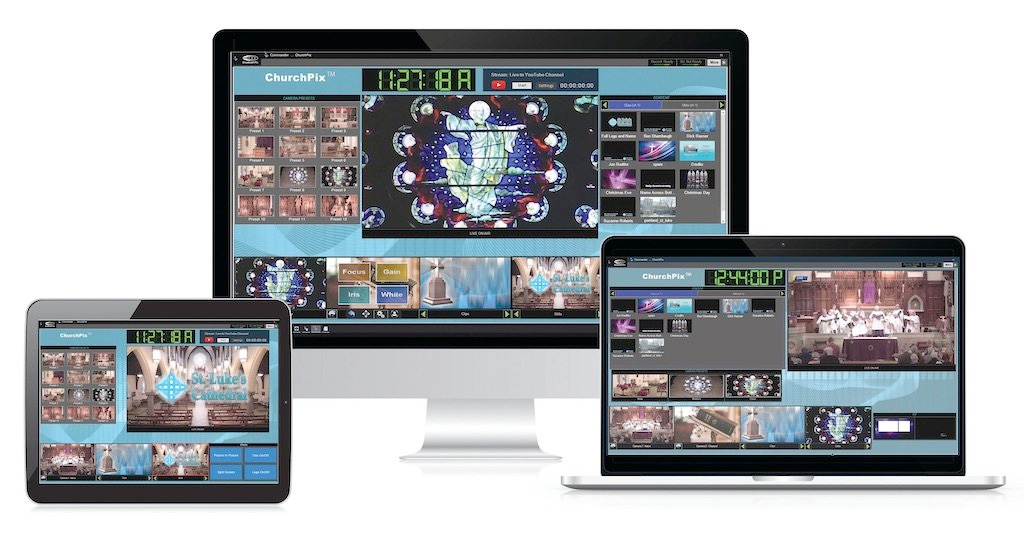It’s a two-camera, turn-key, streaming/recording solution designed for volunteer operators. Between the ease-of-use and single-cable connections, the ChurchPix is as plug-and-play as it gets, making it a fantastic option for the church market.

The ChurchPix system includes two RoboPix PTZ (Pan/Tilt/Zoom) IP cameras, a PC to run the software, one IP switch, and a royalty-free stock library.
Church Production Mag. – March 4, 2022 — Live broadcast production is inherently tricky. There are so many factors to consider, like what content should be distributed, what channels should it be distributed on, and how should it differ from other content already being produced? If those questions aren’t enough to deal with, add what kind of gear is needed, and you have a recipe for an overwhelming amount of information and decisions that need to be made. Broadcast Pix is trying to simplify the gear question by introducing a turn-key system that could have a church up and streaming in no time. The ChurchPix system is designed specifically for houses of worship and their unique needs, namely volunteer operators. Rather than having a traditional hardware interface, the ChurchPix is a software-based solution heavily reliant on macros. The logic behind this is pretty solid; rather than sticking with the standard interface, which only helps people trained on broadcast switchers, the ChurchPix interface functions more like a blank canvas waiting for the end-user to decide what is essential.
Primer on NDI
To appreciate the simplicity of setup for the ChurchPix system, you need to know a little about NDI (Network Device Interface). According to Wikipedia, NDI “is a royalty-free software specification developed by NewTek to enable video-compatible products to communicate, deliver, and receive high-definition video over a computer network in a high-quality, low-latency manner; that is frame accurate and suitable for switching in a live production environment.” It’s basically video over an IP network — a network that is already available in most buildings. So many churches already have an infrastructure that will support the ChurchPix, and if not, the number of cables required is minimal compared to an SDI infrastructure of the same size.
System Details
The ChurchPix system includes two RoboPix PTZ (Pan/Tilt/Zoom) IP cameras, one PC to run the software, one IP switch, and a royalty-free stock library. The RoboPix cameras are equipped with NDI and PoE (Power over Ethernet), so they only require one cable for everything; power, control, and signal. While they feature a small form factor, they also have a 1/2.8 inch high-quality HD CMOS sensor, a 20X optical, and 10X digital zoom. On the output side, the RoboPix features HDMI and SDI outputs, but to get the most out of the cameras, the NDI output is the way to go.

The ChurchPix software can be controlled through a phone or tablet, allowing multiple operators on multiple interfaces to work on the same device.
The PC is a small but powerful PC workstation with a 3.6 GHz Core i-5, 256 GB of NVMe storage, and 16GB of RAM. It’s strong enough to do what it needs to without being an overly expensive workstation, and it’s small enough to be very portable. The ChurchPix PC doesn’t have a native program output because it’s designed to stream and record, which it can do simultaneously. However, since it is an NDI device, an NDI-to-HDMI converter should be all that is needed to get a signal to a TV in an overflow or cry room. However, the ChurchPix has an HDMI and Display port multi-viewer output, which can control the software natively. It also has a slew of USB 3.1 ports, which means ChurchPix can record directly to external hard drives. As for audio inputs, the software supports any Windows Audio Device, including NDI, Dante, and external USB convertors; basically, any way you would typically get sound into a computer will work.
The ChurchPix software is straightforward to use. Once set up, it can stream to Facebook, YouTube, Vimeo/Livestream, Switchboard Live, Castus Stream, or any CDNs using RTMP. It can multi-stream up to five online destinations simultaneously through the Switchboard Cloud Pro Platform. The ChurchPix software can be controlled through a phone or tablet, allowing multiple operators on multiple interfaces to work on the same device. The PC can handle up to three NDI sources, meaning if you want to use ProPresenter with this system, that is 100% not a problem. ProPresenter 7 features native support for NDI, so if your ProPresenter computer is on the network, it’s ready to go.
In use
Once the cameras are plugged in, the ChurchPix auto-detects them. They can be controlled right from the interface or be programmed with preset positions built into a macro, making recalling shots as easy as a single button push. Once everything is up and running, the interface is as simple as “tap what you want to see,” making it perfect for volunteers. The interface can be driven with a mouse or attach a touchscreen to easily control the system. Set up takes almost no time at all, and for portable churches, this system is small enough to fit in a backpack. Weighing in at about 15 pounds, the bulkiest part of the whole system is whatever monitor is added for use as a multi-viewer.
Conclusion
In the past, I have worked with hardware-based switchers and production systems that were so difficult to understand that they confused the volunteer operators and the staff that were overseeing them. I used to tease that the first video system I worked on at a church, didn’t have a learning curve; it had a learning cliff, which made it difficult to find volunteers because the entry barrier was so high. The ChurchPix has gone 180 degrees from that. The interface can do as much or as little as you want. If three macros will get you through a weekend, make those three macros. You can create more complicated macros if you need things to be a little more complex for special events like Christmas or Easter.
Between the ease-of-use and single-cable connections, the ChurchPix is as plug-and-play as it gets, making it a fantastic option for the church market. With an MSRP of $7,995 for a two-camera, turn-key, streaming/recording solution, I think the ChurchPix checks all the boxes.
Learn more about ChurchPix systems here.
—-
Read the story on Church Production here.
![Broadcast Pix, Inc. [US] Logo](https://broadcastpix.com/wp-content/uploads/2018/05/broadcastpix-inc-sticky-logo7.png)